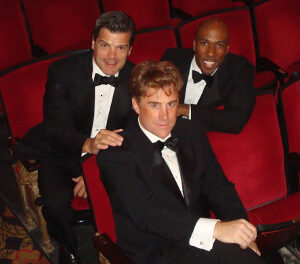I am willing to go out on a limb to proclaim that I heard one of the most compelling choral anthems of our time on Wednesday evening, April 19, in the Nelson Music Room. Prepared to write copious notes and ready to capture as many snippets as possible, I literally dropped my pencil before the close of the evening. If I were to decide upon a theme for this concert, it would be “Color, Conversations, and Humanity.”
Howard Gardner, author of Frames of Mind: The Theory of Multiple Intelligences (1983), describes the development of the composer as one who has reached the highest level of musical competence. Students of the illustrious Duke composition faculty – Professors Stephen Jaffe, Anthony Kelley, Scott A Lindroth, and visiting Professor Marc Faris – surely produced blood, sweat, and tears climbing toward that pinnacle. And breathing life into the five newly birthed works of art, an “all-star” cast of musicians (I borrow the term from a conversation with Ryan Malone) performed five compositions, each displaying mastery of some aspect of contemporary technique.
Youngmi Cho’s Jabbering (2005), inspired by piano jazz great Thelonius Monk, was immediately accessible. Drawing upon technical features of the jazz idiom and creating intricate rhythmic interplay, Cho’s piece is playful and conversational. Three Quodlibets (2005), performed by composer Michael Trinastic, though somewhat strident, provided rich contrast to the former. Translated from the Latin, quodlibet means “what you please.” Often incorporating familiar tunes in counterpoint, this time-honored procedure is traditionally used as a means of delivering virtuosity and humor. Trinastic’s musical intent was made clear through a fine performance.
Kathleen Bader describes her piece, Sabino Interiors (2005), scored for winds and contrabass saying, “…I wanted to create different ‘rooms’ of music that nonetheless belong under the same hypothetical roof.” Like an alchemist, Bader uses swaths of sound (texture and timbre) to evoke visual imagery. Memories of geological features of the American Southwest – shades of ochre, sienna, and red rock – came to mind as I listened.
On the monochromatic side, George Lam’s Momentum Studies (2005), commissioned and premiered by the Golden Triangle Flute Trio of Carnegie Mellon University, looks back to the pattern-pulse works of Philip Glass and others. Sensitively conducted by the composer and expertly played, the piece was mesmerizing.
Finally, twenty-eight year old composer Ryan Malone presented his doctoral dissertation, Stabat Mater (2006). Brilliantly performed by a group of sixteen guest vocalists from New York and New Jersey, the piece was premiered by the same ensemble on Palm Sunday at Sacred Heart Church in Bloomfield, New Jersey, where Malone serves as music director. It is a mature, well-developed composition. A setting of the ancient text penned by Jocopone da Toda in the 13th century, Malone’s piece stands in the company of Rossini, Dvorák, and Poulenc, among others.
Malone, well versed in the choral repertoire, claims that a major influence for this piece was Polish composer Krzysztof Penderecki, 20th-century master of texture-timbre writing. Accompanied by a hand drum (played by the conductor), the piece places enormous demands on singers incorporating extremes in tessitura and vocalizations. Solo soprano and tenor soared above the din of the chanting choristers, creating such emotional stir that the audience, at one moment, remained breathless. Despite the paradoxical history of the text, one senses the universality and timelessness of the mother in anguish and the suffering son. For this reason, the Stabat Mater, freshly realized, will surely become a classic. There is more on the horizon for composer Ryan Malone – perhaps an opera? Watch for that name!
Thanks to local professional musicians Michael Kertchner, clarinet, Matthew McClure, tenor saxophone, Glenn Mehrbach, piano, Robbie Link, contrabass, Thom Limbert, drum set, Carrie Shull, oboe, Todd Hershberger, bassoon, and flutists Rebecca Troxler, Nathan Zalman, and Jill Shires. The guest singers were Valerie Bernhardt, Jeanne Brown, Jennifer Cho, Elizabeth Perryman, Kathryn Christiansen, Marion Gayles, Celeste Mann, Kimberly Mesiti, Philip Alongi, Brian Jamieson, Don Sapara, Noah Stewart, Gustavo Ahualli, Glenn Boothby, Liam Hart, and Samuel McDonald.











